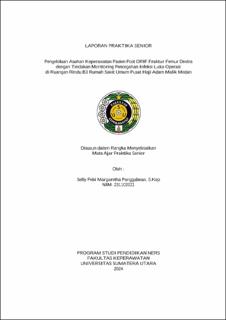Pengelolaan Asuhan Keperawatan Pasien Post ORIF Fraktur Femur Dextra dengan Tindakan Monitoring Pencegahan Infeksi Luka Operasi di Ruangan Rindu B3 Rumah Sakit Umum Pusat Haji Adam Malik Medan
Nursing Care Management of Post ORIF Fracture Patients Dextra Femur with Preventive Monitoring Measures Surgical Wound Infection in Room RB 3 General Hospital Haji Adam Malik Medan

Date
2024Author
Panggabean, Selly Febi Margaretha
Advisor(s)
Tanjung, Dudut
Metadata
Show full item recordAbstract
In some circumstances, most fracture processes occur when the bone fails to resist stresses, especially bending, twisting and pulling stresses. To find out why and how bones fracture, the examiner needs to be familiar with bone anatomy and physiology so that the examiner is able to further recognize the physical state of the bone and the circumstances of the trauma that can cause the bone to break. One of the ways that can be done to treat fractures is with open reduction or called Open Reduction and Internal Fixation (ORIF). Post ORIF procedures can result in problems or complications such as tingling, muscle strength pain, swelling, or edema found in the operated limb. In addition, there are skin problems or complications such as wound infection, wound dehiscence, and wound visceration. ILO (Surgical Wound Infection) is usually characterized by the presence of pus, inflammation, swelling, pain and an increase in body temperature that feels hot at or around the incision where surgery is performed. The purpose of this senior practice is to carry out nursing care by monitoring the prevention of surgical wound infection to avoid and prevent the occurrence of postoperative infection risk problems. The location of the practice is in the RB 3 inpatient room of the Haji Adam Malik Central General Hospital Medan. Monitoring the prevention of surgical wound infection is given to managed patients with a medical diagnosis of Post ORIF Dextra Femur Fracture and given intervention, implementation, and evaluation. Assessment of monitoring the prevention of surgical wound infection is carried out by assessing the signs and symptoms of postoperative infection. After monitoring the assessment of the prevention of surgical wound infection for 5 days, the results showed that the patient did not experience signs and symptoms of postoperative infection risk.
Collections
- Profession of Nursing [450]
